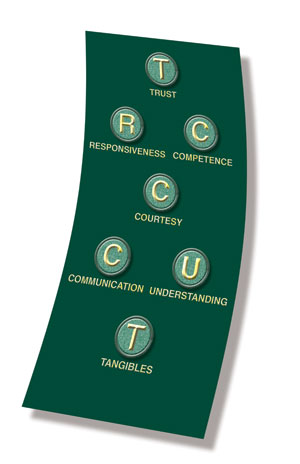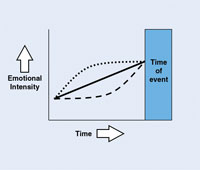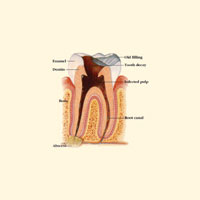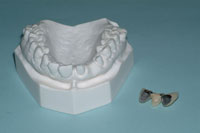In this era of commercial and retail dentistry where extreme renovation is in the spotlight, we must remember that our business is based on who we serve rather than what we sell.
The customer base is the core asset of not only a dental practice, but also of any business. Our goal is to build a foundation of loyal patients, not simply satisfied ones. They are the backbone of our reputation and the voice in the market that states, “This dental practice cares about both my oral hygiene and my general health.”
Satisfied customers are dangerous for any dental practice. They are the routine patients who come regularly, rarely complain, and appear happy to receive treatment. They often sit quietly when things either go well or go not so well. These are also the same individuals who magically disappear. Where did they go? Why did they leave?
First, satisfied customers can be satisfied in many dental settings. They are indifferent and will find another office for nu-merous reasons. Perhaps they found a practice that participates in their insurance network, or maybe one that does not make them wait quite as long to see the dentist or hygienist. Regardless of the reason, they did not see the value in staying.
Second, satisfied customers appear content and pleased with the services provided, but they can easily become dissatisfied. Perhaps the fee seemed high; maybe the staff was not so pleasant one day. Perhaps on a very busy day at the office, the patient felt that neither the doctor nor the staff paid attention to all of his or her needs. Whatever the case, the satisfied customer rarely complains because it is just easier to go somewhere else; he or she is not devoted to the practice. On the other hand, the loyal patient openly communicates with the staff.
These “quiet problems” and situations that erode our customer base every day can easily be addressed. The leading dental practices today are based on a value system that is communicated thoroughly to the patients. We call this system Killer Customer Service.
 |
|
Illustration by Cheryl Gloss |
Security
Patients must feel that they receive the best treatment available and need reaffirmation for their medical, dental, and physiological needs. When these physical and emotional needs are satisfied, the personal encounters flow more readily. The mood must be positive from the initial contact. The patients must feel that your office is a respite from the outside world; they need a place to feel safe where many of their health needs can be addressed.
Relationship
Patients should be the epicenter of a dental practice. Every person on the dental team must make the patient feel better about him- or herself. Communication needs to be a two-way street. Patients want confirmation that they are making excellent decisions; they want reassurance that their voice is heard and their medical needs are your foremost priority. Being part of the process is comforting.
Value
As Sy Syms, chairman of Syms clothing stores, states, “An educated consumer is our best customer.” Patients expect professionalism in all phases of the en-counter. Their need to be fully informed of all the treatment phases and costs are a given; all the positives and potential negatives of treatment must be highlighted. When the staff delivers these clear messages with courtesy and clarity, the patients feel the value of the practice.
Every day the dental staff has the opportunity to build customer loyalty. These moments of truth can come at any time during interaction with patients. The doctors and the staff must be well-prepared to handle these interactions and ensure that each patient is being treated as if he or she is the only patient being seen during the day. We have outlined 7 key areas where these moments of truth appear; they are presented below.
Trust
Building trust translates to establishing relationships. Both the doctor and the staff must have strong people skills to manage the flow of patients throughout the day. Each practice must manage 2 types of trust; the first is functional trust. Sometimes this is the most difficult, as many patients are accustomed to waiting inordinate amounts of time to see the doctor. Unfortunately, they expect to wait. The solution is to meet and greet early. A staff member should always be present to greet patients coming in the door. Patients always are delighted when seen on time, their functional trust is on the rise, and they will probably tell others about it.
The business systems that the doctor sets up and that staff members perform seamlessly impact the other areas where functional trust is built. These include sharing the value of a service when presenting payment options and handling insurance questions. Loyal customers appreciate when this part of the transaction is handled with ease. The person is fully aware of all costs, and at no time is surprised by cost-added services, such as when a beautiful white restoration replaces an amalgam filling. In fact, these are the people who will give you feedback both positive and negative about things that were or were not handled properly. Loyal patients provide the practice a chance to improve and avoid future problems.
The second type of trust is personal trust. All of the 3 critical needs are established and can be fulfilled during this phase. People feel comfortable and safe in your office, they feel better about themselves by making the appointment, and they know they will be treated kindly and fairly.
Loyal customers always feel good about the people in your office. Building trust requires us to make adjustments and remain flexible with customers. The relationship is much like a bank account. What does one need to make a withdrawal (be-sides the ATM card)? The account must have money in it; thus, deposits have been made. When we need something from a patient, we must have something in-vested. When the office is cold and heartless, patients are likely to feel an increasing deficit in the account. Strong relationships are a must for the successful dental practice.
The final area of trust comes with reliability. The loyal patients come to expect the same level of professionalism with each visit. In fact, they are so confident in the service that they concentrate on 2 things: their oral hygiene and the interactions with the people in the office. These interactions turn the routine dental visit into a pleasant experience.
Responsiveness
Have you and all your team members listened and heard your patients today? Did you wait for an answer when you asked Mrs. Johnson what you could do for her?
Often, the doctor sets his or her business infrastructure around the ability to perform needed tasks. The daily schedule shifts to meet the doctor’s needs, and pa-tients wait for the “right time” to see him or her. On a good day, the schedule runs smoothly and patients do not wait an unreasonable amount of time. On other days, the scheduled patients wait, and the unscheduled are told there are no openings. This is an old paradigm—the practice is built around the doctor.
The new paradigm, the 21st century mindset, is the patient-centric practice. All activities focus on them. While even the best-run practices cannot always squeeze in patients, those dedicated to killer customer service make the effort and often accommodate the patient who needs an immediate assist. Trust plays a role, as the staff might need to ask someone to switch an appointment. Loyal patients are always glad to help out. The practice is run as a business should be run—the patient comes first. Customers so appreciate such responsiveness that they rave about it to others.
Why? The answer is easy: most dental practices do not follow these common business practices.
Competence
The doctor’s ability to perform excellent treatment is only a part of a patient’s concerns. They want the entire staff to be equally professional and competent. As in any business, behavior modification and skill development come from training. Are the people in the office prepared to manage both the patient interaction and the patient account? Loyal pa-tients understand that these needs are being met regularly. They do not have that uneasy feeling that the transaction has some loose ends. They feel equally good about the treatment by the doctor and the staff. If the doctor is excellent but the staff performance is me-diocre, then some patients might return, but there are no guarantees for how long they will stay. These pa-tients are in the danger zone.
Courtesy
All dental practices want to be busy. The base concept for all businesses is supply and demand. With so many people paying attention to oral hygiene, what gives a practice the competitive advantage? In short, it is the practice that values people and treats them with courtesy, care, and dignity. A practice cannot afford to be overwhelmed to the point where patients are barely acknowledged when entering the office. They cannot afford to ignore those who have been waiting for awhile. Of course, every office must go into crisis mode at some time or another. At these hectic times every practice faces critical moments of truth in developing loyal patients. How these interactions (during a flurry of activity) are managed make the difference between leaving patients in the danger zone or converting them to loyal patients.
Communication
Communication is the lifeline of any business. A dental practice is no exception. When developing loyal patients, we need to look at both internal and external communication. Both are equally important. Internally, do the staff and doctors communicate well with one another? Are there internal conflicts that are not resolved? A practice is a team of people working together for a common objective: to provide the best oral care for its patients. The team approach allows for conflict resolution and establishes the advantage of developing loyal patients. Formally, there should be team meetings held on a regular basis. Informally, there should be daily “huddles” where the staff gets together to manage the challenges of the day. This builds trust and loyalty among team members, a necessity for the practice that maintains loyal patients.
External communication provides the vital link between the practice and its patients. This communication centers on 3 areas: pre-appointment, face-to-face, and post-appointment. In pre-appointment communication the patients should be confirmed for their appointments. Many practices are now finding success with e-mail confirmations. Perhaps this is less personal, but the e-savvy and the very busy patients find this to be effective and efficient. There still needs to be a process of calling the patients who do not prefer e-mail communication. Another aspect of pre-appointment communication is letting the patient know how to best prepare for the appointment. Some patients need a reminder to premedicate; others need to remember to bring a letter from the insurance company.
The second area of external communication is face-to-face. The staff needs to let the patient know what to expect during this appointment. This level of communication is important for even routine procedures such as x-rays, cleanings, and consultations. The most important part of face-to-face communication is the doctor’s ability to connect with the patient. A doctor who is competent, listens, and cares is far more likely to have loyal patients than those who are competent but cold.
Post-appointment communication is the one area most practices do not perform well. After a difficult procedure, the staff should call the patient to see if there were complications. Most practices follow the concept that “no news is good news,” but this is not a characteristic of Killer Customer Service. A simple follow-up call leaves a lasting impression of genuine concern on a personal level.
Understanding
Patients want to be understood. They need to know that the dental staff has excellent listening skills and provides the empathy needed to make them feel secure. A big complaint that pa-tients have is that the practice does not understand their complete overall health concerns and only wants to “process” them through their appointment. A patient who feels that the staff is listening and understanding feels that everything is being done to provide them with the best possible service.
Tangibles
Tangible results are the most important part of patient loyalty. First, patients want their pain alleviated; second, they want to “look” better; and third, they want to forget about any problems they have with their teeth. Without these tangibles, patients will not return. Other tangibles in-clude the cutting-edge products that they can purchase at the office. For example, they enjoy the newest toothbrushes, the best water irrigators, and other leading-edge products. Another tangible that patients love is the free “goodie bag” that they receive at the end of a visit: a new brush and new floss. Loyal patients come to expect such treats at the end of their appointments.
CONCLUSION
Killer Customer Service is the complete process of taking care of patients through a developed and skillful effort by the dental practice. In the United States today, we are in the golden age of dentistry. Never before have Americans been so aware of how oral hygiene impacts their overall health. As a result, there is a demand for excellent service. Far too many dental practices are not versed in the rigors of customer service. The most successful practices are the ones that implement a program, develop it over time, and refine it continuously. They have the competitive advantage of gaining lifelong loyal patients.
Dr. Varallo is a 1980 graduate of Farleigh Dickenson Dental School. He is a member of the International Academy of Dental-Facial Aesthetics, an AGD trained speaker,
an associate fellow of the World Clinical Laser Association, and serves on the clinical advisory board for DENTSPLY. He owns and operates the Nantucket Dental Society as well as maintains the successful patient-centric practice, Ho Ho Kus Dental Associates, in Ho Ho Kus, NJ. He can be reached at (201) 670-9076.
Mr. Varallo, senior-level consultant, has more than 20 years of experience as a facilitator, a coach, and a trainer with global companies. His projects include Killer Customer Service, Presenting With Impact, and Executive Coaching. His clients include Citigroup, Hoffmann-La Roche, The Chase Manhattan Bank, and BMW. He uses an interactive style that engages and motivates his audience members to improve their communication skills. A top business consultant and public speaker, he helps organizations achieve success in customer service. He can be reached at (201) 444-1946.











